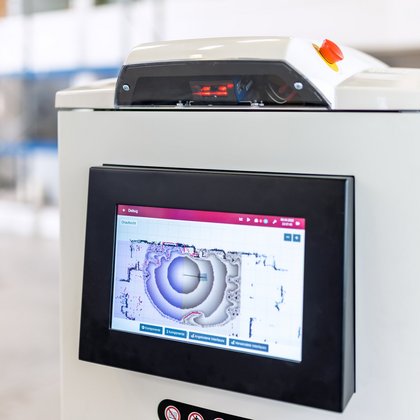As diverse as the requirements on driverless transport systems are the solutions DS AUTOMOTION has developed in this field in nearly 40 years. The new ARCOS vehicle software lends the vehicles of this premium manufacturer the ability to make the choice between virtually rail-guided operations as AGVs and fully autonomous driving modes as AMRs. Interacting with the NAVIOS fleet control software, it facilitates cooperative and collaborative navigation with plannable autonomy. DS AUTOMOTION thus combines high flexibility with maximum reliability and efficiency.
Share article
DS AUTOMOTION software to maximize flexibility, efficiency and safety
While driverless cars, trucks and buses are completing a first set of test runs on our roads, unmanned vehicles have been reliably conveying their cargoes from A to B for many years in factory halls and hospitals. There, automated guided vehicles (AGV) take on more and more internal transport tasks. The past few years showed a trend toward autonomous mobile robots (AMR). Until recently, though, their high flexibility came at the cost of reduced efficiency and a less determinable material flow.
DS AUTOMOTION GmbH has been a leading manufacturer of driverless transport systems and autonomous mobile robotics since 1984. The company based in Linz, Austria, has been relying on in-house competences for the development of both control and navigation systems and vehicles. “This enables us to master the various technologies and combine them to fulfill the diverse requirements of individual applications”, says Ing. Kurt Ammerstorfer, MA, senior manager sales, product management and Marketing for DS AUTOMOTION.
ARCOS is setting new Standards
The ARCOS (Autonomous Robot Control & Operating System) vehicle software newly developed by DS AUTOMOTION engineers extends potential uses of the vehicles and lends them added application flexibility. As well as physical or virtual guidance using any of the relevant technologies and contour-based, autonomous navigation, they can autonomously make decisions under certain conditions. This ensures timely deliveries even in exceptional situations.
“DS AUTOMOTION AGVs can navigate cooperatively and collaboratively“, DI Dr. Andreas Richtsfeld, DS AUTOMOTION technology and product development, confirms. “They are fit for fully autonomous swarm operation.” Artificial intelligence (AI) algorithms facilitate not only fully autonomous evasive action within user-defined boundaries to circumvent unexpected obstacles, but also the interplay of several AMRs in open space.
Intuitive User Interface
ARCOS features a web-based, multilingual visualization. Its user interface is compatible with all popular mobile devices. This allows the location-independent retrieval of vehicle status information at any time. Operators also benefit from the ability to change configuration settings during operations and full operation and condition data recording.
Based on this, ARCOS also facilitates simulation. With numerous wizards, ARCOS eases and accelerates commissioning, operator training and maintenance. The software’s multi-level user and rights management ensures maximum security.
Plannable Autonomy
Meeting the tough requirements of day to day operations in industrial applications takes more than an autonomously navigating vehicle. If AMRs need to consult with each other every time they meet at a crossing, for example, transport performance would be lower than if they operate according to rules stored in and executed by a central system.
The NAVIOS fleet control software is the intelligence behind DS AUTOMOTION’s flexible AGV solutions. It supplied the AGVs with precise routing information and rules the interaction with other traffic, for instance manned forklift trucks or lorries, and with installations such as lifts, moving ramps or rolling gates. Other than most fleet management systems, NAVIOS is a full-fledged intralogistics system. It can autonomously interpret requirement data to create transport orders and control the entire automated material flow.
The interplay between the ARCOS vehicle software and the NAVIOS fleet control software prevents the vehicles’ autonomy from compromising the system’s efficiency. This enables DS AUTOMOTION AMRs to cooperatively and collaboratively navigate with a plannable degree of autonomy. It allows defining navigation corridors within which AMRs find their own way. “Users can provide the autonomous vehicles with room for fully autonomous maneuvering where this makes sense and is safe”, explains Thomas Gschwendtenwein, head of technology & product development for DS AUTOMOTION. “This plannable autonomy combines a high degree of flexibility, for example through the ability to avoid congestion or circumvent unexpected obstacles, with maximum efficiency for economic vehicle utilization.”
Spearheading VDA5050 Standardization
NAVIOS makes full use of the VDA-5050 universal interface for communication with AGVs and AMRs. This standardized and open interface facilitates mixed operations integrating third-party vehicles as well. DS AUTOMOTION plays a leading role in the development of this interface within the Mechanical Engineering Industry Association (Verband Deutscher Maschinen- und Anlagenbau; VDMA) materials handling and logistics association.
Christoph Pramberger, MSc, is heading the recently established group working on a standardized Layout Interface Format (LIF) to complement the communication interface. “This will further ease and accelerate AGV system commissioning”, the DS AUTOMOTION requirements engineer is positive.

